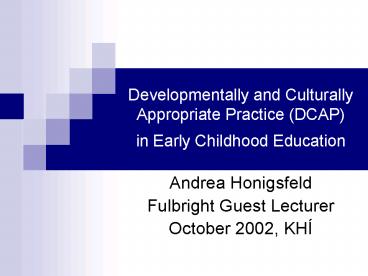Developmentally and Culturally Appropriate Practice DCAP in Early Childhood Education - PowerPoint PPT Presentation
1 / 12
Title:
Developmentally and Culturally Appropriate Practice DCAP in Early Childhood Education
Description:
(NAEYC, 1987) DAP. AGE APPROPRIATE. INDIVIDUALLY APPROPRIATE. Physical. Emotional. Social ... Learning experiences that are meaningful, relevant, and respectful of all ... – PowerPoint PPT presentation
Number of Views:787
Avg rating:5.0/5.0
Title: Developmentally and Culturally Appropriate Practice DCAP in Early Childhood Education
1
Developmentally and Culturally Appropriate
Practice (DCAP) in Early Childhood Education
- Andrea Honigsfeld
- Fulbright Guest Lecturer
- October 2002, KHÍ
2
What is DAP?(NAEYC, 1987)
What is missing from DAP?
3
DCAP
What is missing from DAP?
Social and Cultural Context Learning experiences
that are meaningful, relevant, and respectful of
all cultures represented in the
class Developmentally and Culturally Appropriate
Practice
4
How is diversity defined by NCATE?(National
Council of Accreditation for Teacher Education)
- Differences among groups of people and
individuals based on ethnicity, race,
socioeconomic status, gender, exceptionalities,
language, religion, sexual orientation, and
geographical area.
5
The key questions of DCAP(Based on Hyun, 1998)
- What relationships do students see between the
activity or the work they do in school and the
lives they live outside of the classroom?
6
Key questions, continued
- Is it possible to incorporate aspects of
students lived culture into the work of
schooling without simply confirming what they
already know?
I know that.
7
Key questions, continued
- Can this incorporation be practiced without
devaluing the objects and relationships important
to students?
8
Key questions, continued
- Can this practice succeed without ignoring
particular groups of students as others within
a dominant culture?
9
How do we get there?
- Multicultural Education
- Anti-bias Curriculum
- Culturally Congruent Critical Pedagogy
10
Multicultural Education
- Goals
- To help children become more aware of themselves
as individuals and of their cultures and/or
cultures - To help them develop an understanding of and
appreciation for the cultures of others - To help them develop knowledge, attitude,
patterns of behavior, and skills to function
cross-culturally
11
Anti-bias Curriculum
- GOALS
- To enable every child to construct a
knowledgeable and confident self-identity - To develop a safe, just, and diverse interactive
learning environment - To foster critical thinking about bias and
stereotyping - To develop the knowledge and skills needed to
stand up for oneself in the face of injustice
12
Culturally Congruent Critical Pedagogy
- Allows children to express and show the
importance of their own family culture and
identity - Employs childrens personal experience, family
culture, and diverse language expressions as
important sources of learning and teaching - Respects differences in perceiving, learning,
understanding, and decision-making































